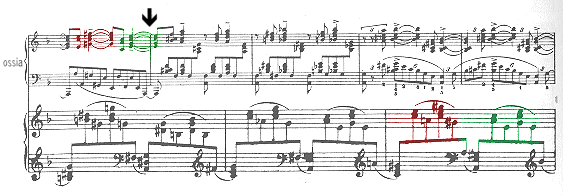 |
The
Hands of
Sergei Rachmaninoff
Ossias
![]()
What a wonderful thing! The ossia (just in case you don't know) is a sort of alternative to the standard notation. It usually has the same musical ideas and developments, but it is somehow stated in a different way. It can be used to make a certain section of music simpler, or more complex. Rachmaninoff often used them to provide a textural change. Usually the ossias in Rachmaninoff's music seem to represent a more thick or complicated texture. The ossia is a real treat for the performer. They get to choose which version is most suitable for their performance of the piece. The Third Concerto has plenty of ossias to keep the pianist entertained for a long time.
The most famous ossia in the concerto is part of the first movement cadenza. Spectacular in either form, the cadenza is always a point of intereset and a matter of debate. This is one of the more amazing things written for the piano. The original cadenza is the more cordal one. It is longer, immensely more thick-textured, and perhaps a little too coda-like. This is what prompted Rachmaninoff to write the alternate cadenza. This cadenza is shorter and faster but no simpler. The same musical developments and ideas are present, just in an altered form. This is important to note because the cordal cadenza is written as the ossia even though it was written first. Rachmaninoff and Horowitz invariably played the short cadenza. Horowitz said of the ossia that it is "like an ending in itself. It's not good to end the concerto before it's over!" Ideed he was right (how can he be wrong with a statment like that.)
Rachmaninoff![]()
Horowitz 1941![]()
Ashkenazy ![]()
Another interesting thing regarding this cadenza is that the entire cadenza doesn't have an ossia. These two texturally different statements converge near the end to climax the movement. The issue of a few bars that have been cut by Rachmaninoff, Horowitz and others have been deemed "musically impossible" by Horowitz. This was his way of indicating that they were redundant. The specifics of this are discussed further in the Cuts section.
There have been some interesting things done with this cadenza
that are certainly worth mentioning. The boldest venture is that of Andre
Watts. In his 1969 recording of this work with Ozawa and the New York
Philharmonic, he doesn't just choose one cadenza or the other, he combines
them. This sounds absolutely impossible, but I really think that he manages
to pull it off quite well. I sure as hell can't play this cadenza, so
it makes it really tough for me to figure out exactly where he goes from
one alternative to the other. My best approximation is show below. Click
here to listen ![]() , try to watch
for the change!
, try to watch
for the change!

Watts plays the regular cadenza through the end of the line shown ending with the green notes and then switches to the ossia at the arrow just after the green notes. This makes sense musically notice how the color highlighted chords match in both parts.
Another, more subtle change was made by Horowitz. Here Horowitz makes the cadenza more pianistic without making it less musical. (This was the driving force in Rachmaninoff's music and Horowitz's transcriptions and his own music) Horowitz moves around some chords and makes it sound, perhaps, more dramatic. Not surprisingly Byron Janis follows in his teacher's footsteps and plays it similarly. Emil Gilels also plays it Horowitz's way. See the pictures below:
From the Score:

Horowitz Version:

There is one ossia in the second movement, but I have never heard it played. Basically it substitutes single sextuplets for regular sixteenth notes or two note chords of sixteenth notes. The section in question has only been recorded in recent years because Rachmaninoff and Horowitz cut this section from their recordings (with the exception of Horowitz 1978 recordings) and the earlier recordings (through about the 1960's) followed thier lead.
In the finale, there are two ossias. The first ossia is
quite novel. The only recording that I have heard of this ossia is by
Evgeny Kissin. Listen to this sample.![]() If you are familiar with this part of the concerto, you will recognize
the difference right away. With almost twice as many notes, this one is
so much more orchestral. VERY DIFFICULT though. The other ossia in the
finale is on the very last page. Here again Andre Watts has done something
few others have by playing this ossia. In fact, his is the only recording
of that ossia that I am aware of. Here Rachmaninoff substitutes quater
note triplets with regualr eighth notes. It's really different when you
first hear it, but it's done well, Watts is a great technician (Watts
musically. . . well we'll leave that alone for now) Listen to it and decide
for yourself.
If you are familiar with this part of the concerto, you will recognize
the difference right away. With almost twice as many notes, this one is
so much more orchestral. VERY DIFFICULT though. The other ossia in the
finale is on the very last page. Here again Andre Watts has done something
few others have by playing this ossia. In fact, his is the only recording
of that ossia that I am aware of. Here Rachmaninoff substitutes quater
note triplets with regualr eighth notes. It's really different when you
first hear it, but it's done well, Watts is a great technician (Watts
musically. . . well we'll leave that alone for now) Listen to it and decide
for yourself.![]()